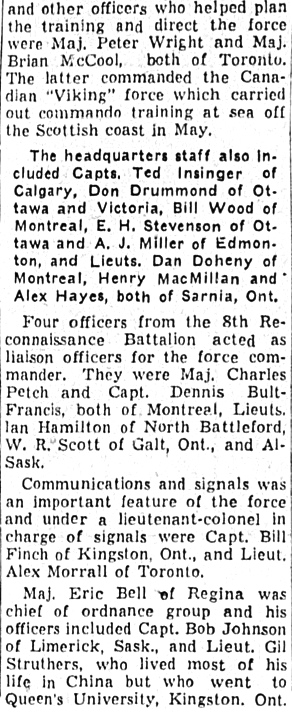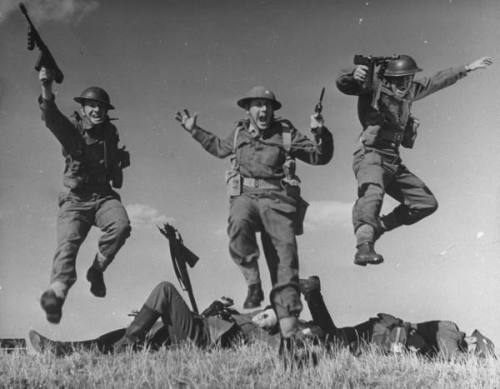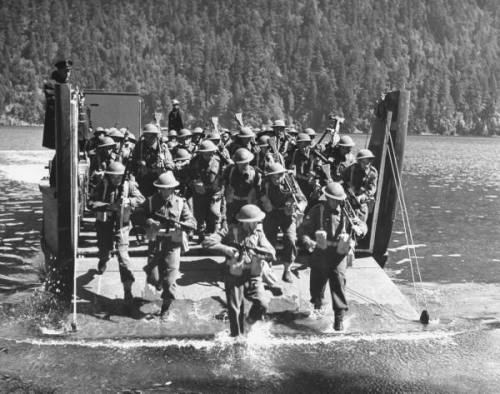War-Mauled Photographer, Invasion Drills, Snooping on Nazis, and More
News from The Winnipeg Tribune, July 31 - August 3, 1942
[Photo: A still from a World War II film that highlights the role of Canadian corvettes on convoy duty in the North Atlantic. Battle scenes show a crew sighting a German submarine and sinking it. Other scenes show training on the high seas. Link - Action Stations by Joris Ivens]
Introduction:
Most WW2 newspaper columns related to actions involving 'Canadians in Combined Operations' (950 - 1000 sailors, incl. a smaller number of officers) do not directly mention that handful of volunteers I am most interested in learning more about (including my father), who first, joined the RCNVR in approx. mid-1941, and second, Combined Operations - a British organization, with HQ in London, charged with offensive operations, e.g., raids and invasions (incl. Dieppe, North Africa, Sicily, Italy, etc.) - in late 1941.
That being said, I find a lot of news columns, editorials, accompanying editorial cartoons, and more, very informative.... and flavourful. I learn more about the times and factors that relate to the successes and failures that would have affected my father and mates as they trained aboard landing crafts in Scotland or, e.g., in southern England in the weeks before the Dieppe raid.
From The Winnipeg Tribune:
Invasion drills for Dieppe took place in southern England, including perhaps on the beaches of Isle of Wight in July. Before that, in Scotland (south of Irvine, near Troon. Units assigned to the Dieppe Raid are mentioned below:
General Marshall, mentioned below, wanted to cross the channel to France in 1942. Did this apply pressure upon PM Churchill for the ill-fated Dieppe raid?
Heavy weights upon the Allied political and military scene (Presidents, PMs, heads of state, heads of war depts., etc.) had much to say about a cross-channel operation or alternative (e.g., invasion of N. Africa, focus upon the Pacific, and more) in 1942. The raid upon the heavily-fortified beaches of Dieppe may have been the result - in part - of the many competing discussions between many, various forces at play in the summer of 1942.
Taking all of the 'fateful' talk and planning into account, we know for certain 'things did not end well' for Canadian troops.
Capt. Osmond Borradaile, featured above, is listed in credits as cameraman in a National Film Board (NFB) documentary film entitled "Action Stations" (by 'Jorvis Ivens', re life aboard corvettes, WW2), very much worth a look for many readers here I am sure.
Please click here to link to "Action Stations"
Top-rated athletes are mentioned below, and in another entry I featured Canadian Navy boys who helped a CFL team win the Grey Cup in 1944.
Outweighing talk of football prowess is the constant call for a Second Front and the where and the when. Even the Nazis weigh in:
During 1942 a film entitled "The Commandos Come At Dawn" was made on Canada's west coast. At the same time, some parts of the film were used to assist with the training of "Canadian and American guerilla fighters."
Movie poster and caption below, as found at - IMDb website
Most WW2 newspaper columns related to actions involving 'Canadians in Combined Operations' (950 - 1000 sailors, incl. a smaller number of officers) do not directly mention that handful of volunteers I am most interested in learning more about (including my father), who first, joined the RCNVR in approx. mid-1941, and second, Combined Operations - a British organization, with HQ in London, charged with offensive operations, e.g., raids and invasions (incl. Dieppe, North Africa, Sicily, Italy, etc.) - in late 1941.
That being said, I find a lot of news columns, editorials, accompanying editorial cartoons, and more, very informative.... and flavourful. I learn more about the times and factors that relate to the successes and failures that would have affected my father and mates as they trained aboard landing crafts in Scotland or, e.g., in southern England in the weeks before the Dieppe raid.
* * * * * * *
From The Winnipeg Tribune:
Invasion drills for Dieppe took place in southern England, including perhaps on the beaches of Isle of Wight in July. Before that, in Scotland (south of Irvine, near Troon. Units assigned to the Dieppe Raid are mentioned below:
General Marshall, mentioned below, wanted to cross the channel to France in 1942. Did this apply pressure upon PM Churchill for the ill-fated Dieppe raid?
Heavy weights upon the Allied political and military scene (Presidents, PMs, heads of state, heads of war depts., etc.) had much to say about a cross-channel operation or alternative (e.g., invasion of N. Africa, focus upon the Pacific, and more) in 1942. The raid upon the heavily-fortified beaches of Dieppe may have been the result - in part - of the many competing discussions between many, various forces at play in the summer of 1942.
Taking all of the 'fateful' talk and planning into account, we know for certain 'things did not end well' for Canadian troops.
Capt. Osmond Borradaile, featured above, is listed in credits as cameraman in a National Film Board (NFB) documentary film entitled "Action Stations" (by 'Jorvis Ivens', re life aboard corvettes, WW2), very much worth a look for many readers here I am sure.
Please click here to link to "Action Stations"
Top-rated athletes are mentioned below, and in another entry I featured Canadian Navy boys who helped a CFL team win the Grey Cup in 1944.
Outweighing talk of football prowess is the constant call for a Second Front and the where and the when. Even the Nazis weigh in:
During 1942 a film entitled "The Commandos Come At Dawn" was made on Canada's west coast. At the same time, some parts of the film were used to assist with the training of "Canadian and American guerilla fighters."
Movie poster and caption below, as found at - IMDb website
A gentle widower, enraged at Nazi atrocities against his peaceful
Norwegian fishing village, escapes to Britain and returns leading
a commando force against the oppressors.
Another version of the movie poster, as found at - Amazon Magazine Print
Press Photo and details below, as found at - Historic Images Outlet
Press Photo and details below, as found at - Historic Images Outlet
1942 PRESS PHOTO FILMING THE CANADIAN MOVIE
"THE COMMANDOS COME AT DAWN"
More information is presented below about the film, as found at - The Islander
“Commandos Strike at Dawn”
These days, Victoria and Vancouver Island are well known as a premier location for filming everything from feature films to television series and every thing in between. Vancouver Island’s role in the film industry is oft touted as recent phenomenon, due to its oft publicized growth over the last few years. However an Islander article about the Cedar Grove Tearoom that to used to operate at Goldstream in the 1930’s and 40’s proves that Victoria’s involvement in the movie industry goes back further than many people think.
While most of the article is fairly unexceptional, the author mentions that in 1942, the Goldstream area was selected as the primary filming location for the movie “Commandos Strike at Dawn”, starring Hollywood star Paul Muni. During the shooting, the Tearoom hosted the cast and crew, as well as a group of about a hundred Canadian soldiers who played the Commandos in the movie. The main locations where the film was shot included Saanich Inlet which stood in as a Norwegian fjord, and the Victoria International Airport, which was nothing more than a simple airstrip at the time. Predictably, while the movie was being filmed, it generated a fair amount of excitement in sleepy Saanichton; the cast, crew, and even local teenagers had rowdy evening parties together throughout the duration of the filming.
As a Victoria local it is quite easy to recognize familiar aspects of the Victoria region in the scenes of the movie. When watching the trailer, the sensationally melodramatic military action scenes in the movie seem to be slightly less glamorous given the familiarity of the fields and fir trees in the background.
You can watch the trailer from the movie here. (Type "Commandos Strike At Dawn" onto the search line).
Some naval actions in the English Channel about two weeks prior to the Dieppe Raid are mentioned below:
More news clippings, editorials, cartoons, ads, etc., will follow on this site (chiefly from The Winnipeg Tribune) to provide general information related to ongoing wartime events - at home and abroad an inside movie theatres - shortly before the Dieppe Raid.
Please link to Context: Dieppe Raid 1942 - Operations RUTTER/JUBILEE (8)
Unattributed Photos GH

















































No comments:
Post a Comment